From Las Vegas to Reno, the Silver State is home to some amazing birds. With 479 species observed on ebird, Nevada’s changing seasons and vast geography provide for a diverse habitat. In this post, we’ll review 30 of the most common and colorful birds in Nevada along with some helpful data on when and where to find them.
We even sampled 5 years of aggregate data from ebird’s Nevada checklists to compile easy-to-use statistics and graphs to help identify each bird species. So whether you’re just watching the backyard bird feeder or venturing to birding hotspots like Henderson Bird Viewing Preserve or Clark County Wetlands Park – we’ll have you ready to start bird watching like a professional.
American Kestrel

The American Kestrel can be seen year-round in Nevada.
- Falco sparverius
- Size: 9″ (23cm)
- NV Checklist Frequency High: 13% in August
- NV Checklist Frequency Low: 6% in February
Identification and Color: Known as the smallest falcon. They have intricate patterns and multiple colors. Their bodies are covered with black spots. The male’s body has a top color of rusty red, then a grey or blue strip, then white. A female is red and white without the blue-grey stripe. Both sexes have black slash marks on their heads.
Habitat and Behavior: Found throughout the United States and some parts of Canada. Their habitat can vary but they prefer open spaces and perching high up above the ground. Will often spot prey from their high perch and swoop down on it.
Diet: The American Kestrel will feed on large insects such as grasshoppers or beetles. They will also catch small mammals or reptiles.
American Robin
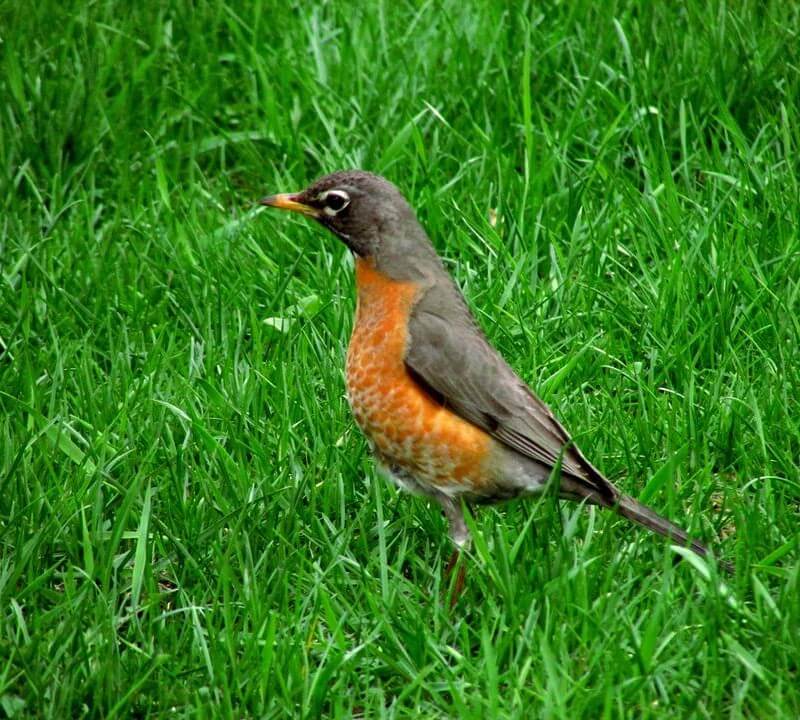
Abundant throughout the entire country and commonly a welcome indicator of spring in northern states. The American Robin is a common sight in Nevada.
- Turdus migratorius
- Size: 9-11″ (22.5-28cm)
- NV Checklist Frequency High: 36% in June
- NV Checklist Frequency Low: 14% in September
Identification and Color: Reddish-brown breast (almost looks pot-bellied) and grey back. The female usually has a lighter plumage than the male. Males have a darker black head.
Habitat and Behavior: The American Robin is found in open woodlands, gardens, and parks. It often forages for food on the ground cocking its head to the side in an effort to find worms. When it’s not eating, the American Robin can often be seen perched on a branch singing its cheerful song.
Diet: The American Robin feeds on insects, worms, berries, and fruits.
Barn Swallow

The Barn Swallow is a small common songbird that is often seen swooping in flight. Typically found in Nevada during the summer months.
- Hirundo rustica
- Size: 7″ (17 cm)
- NV Checklist Frequency High: 21% in April
- NV Checklist Frequency Low: 1% in Winter
Identification and Color: Easily identified by its long forked tail. Has a shiny blue hood and back with orange underparts.
Habitat and Behavior: Found in fields and meadows, specifically for foraging. Can also be seen near lakes and ponds. These birds are attracted to barns and other buildings because they provide a safe place to build their nests. These birds are known for their aerial acrobatics and often perform flips and twists while flying.
Diet: The Barn Swallow feeds on insects, which it often catches in mid-air. Can also be seen skimming the water’s surface for a drink.
Bewick’s Wren

The Bewick’s Wren is a year-round resident of Nevada.
- Thryomanes bewickii
- Size: 5″ (13 cm)
- NV Checklist Frequency High: 16% in April
- NV Checklist Frequency Low: 5% in August
Identification and Color: Bewick’s Wrens have brown along their backs and wings with grey to white on their undersides. They have long tails with black spots and white spots on the sides. The bills are long, slender, and have a slight curve going down. Both sexes have similar coloring but some warmer climates may have a reddish brown color.
Habitat and Behavior: Found between the west coast and the southwest. Favors dry areas of underbrush, thickets, or scrub. Can be found in some populated areas. Will climb or jump through the brush to forage. During mating season males will sing from their perches.
Diet: Insects such as beetles, ants, or wasps make up the majority of the Bewick’s Wren diet. Will occasionally eat some berries or seeds.
Black-billed Magpie

The Black-billed magpie can be seen year-round in Nevada.
- Pica hudsonia
- Size: 24″ (61 cm)
- NV Checklist Frequency High: 15% in December
- NV Checklist Frequency Low: 7% in August
Identification and Color: Black-billed magpies have black heads with two white patches along the body and blue-green iridescent wings. In flight, the white tips and blue-green colors make a striking image. Very long tail feathers and thick short bills. Fairly large bird between 17 and 24 inches in length.
Habitat and Behavior: Found in the upper northwest and into Canada. A social bird that can be found in large groups. Likes farmland, forest edges, and other semi-open areas. Generally does not migrate far if at all. Will forage on the ground.
Diet: The Black-billed magpie is omnivorous with a varied diet. Enjoys insects, carrion, berries, and seeds.
Brown-headed Cowbird

The Brown-headed Cowbird is commonly seen in Nevada during the warmer months.
- Molothrus ater
- Size: 7.5″ (19 cm)
- NV Checklist Frequency High: 21% in May
- NV Checklist Frequency Low: 1% in Winter
Identification and Color: Males have a chocolate brown head and glossy black body. Females are duller in color with a streaked brown head and body.
Habitat and Behavior: Found in open areas like fields and meadows. Will also frequent forest edges. This bird gets its name from its habit of following cattle around and eating the insects they stir up. The Brown-headed Cowbird is a parasitic nester, meaning it will lay its eggs in other birds’ nests and let them raise its young.
Diet: Mainly insects and seeds. Will visit seed feeders.
California Quail

The California Quail is a year-round resident of Nevada.
- Callipepla californica
- Size: 11″ (28 cm)
- NV Checklist Frequency High: 19% in May
- NV Checklist Frequency Low: 7% in February
Identification and Color: Male and female California Quail have some key differences. Males are grey and brown with black faces and white stripes outlining their faces. Females are lighter brown with no face markings. Both sexes have white and tan scales on their bellies. The most distinct feature between both is a comma-shaped crest on their heads.
Habitat and Behavior: The California Quail is common in California and north of the state. They will stay year-round in the area. Found in woodlands and foothill forests. Can be found in large groups and will forage on the ground.
Diet: A diet based mostly on seeds and leaves. Will eat many different plants, acorns, and berries.
California Scrub-Jay
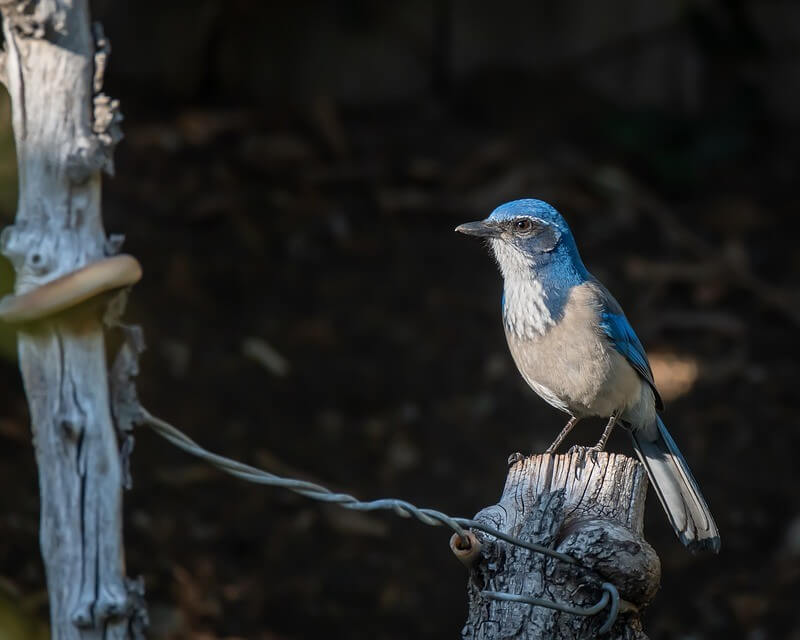
The California Scrub-Jay can be seen year-round in Nevada.
- Aphelocoma californica
- Size: 11″ (28 cm)
- NV Checklist Frequency High: 20% in December
- NV Checklist Frequency Low: 8% in June
Identification and Color: The California Scrub-Jay has a rich blue and grey color on top with lighter white undersides. Depending on the lighting, the blue color can look very dark. A long tail and straight bill with a slight hook at the end of it.
Habitat and Behavior: Found on the west coast and a permanent resident of California as the name suggests. They can be found in open forests of oak and riverside woods. Often found perched very high up, they will forage in trees or on the ground.
Diet: The California Scrub-Jay has an omnivorous diet dependent on the season. Insects in the summer and seeds, nuts, and berries in the winter.
Cliff Swallow

The Cliff Swallow can be seen during the summer months in Nevada.
- Petrochelidon pyrrhonota
- Size: 6″ (15 cm)
- NV Checklist Frequency High: 17% in May
- NV Checklist Frequency Low: 0% in Winter
Identification and Color: The Cliff Swallow has a brown head with black at the very top and a white forehead patch. In proper light, their backs will have a metallic shine on their dark blue feathers. White underparts with brown wings and tails. Rounded wings and a medium-length tail. They have a very short, pointed bill.
Habitat and Behavior: Breeds all over the United States, Canada, and up to Alaska. A very long-distance migrant bird that will go all the way to southern South America. Will build their nests on upright surfaces like cliffs, bridges, or culverts. Will catch insects on wings for foraging.
Diet: The Cliff Swallow enjoys a wide variety of insects, including many flying insects such as bees, wasps, and flies. They will occasionally eat berries.
Dark-eyed Junco

The Dark-eyed Junco is a small, sparrow-like bird that is one of Nevada’s most common winter birds.
- Junco hyemalis
- Size: 6″ (15 cm)
- NV Checklist Frequency High: 33% in December
- NV Checklist Frequency Low: 4% in May
Identification and Color: Rounded dark head and eyes. Charcoal back and white breast.
Habitat and Behavior: Enjoys a variety of wooded habitats throughout Canada and the northern United States. Dark-eyed Juncos are typically found in open woods, forest edges, weedy fields, and backyards. In winter they often form flocks and can be seen feeding on the ground beneath bird feeders.
Diet: Dark-eyed Juncos eat mostly insects and seeds.
Downy Woodpecker

The Downy Woodpecker can be seen year-round in Nevada.
- Picoides pubescens
- Size: 6″ (15 cm)
- NV Checklist Frequency High: 7% in September
- NV Checklist Frequency Low: 5% in March
Identification and Color: Adult Downies are black and white, with a black back, white belly, and a small patch of red on the back of the head. They have a short bill and a barred tail.
Habitat and Behavior: Downy Woodpeckers live in forests, woodlands, orchards, and suburban areas. They are year-round residents in most of their range. They forage on tree trunks and branches, using their bills and barbed tongue to peck at bark to find food.
Diet: Downies feed on insects, spiders, berries, and nuts. Downies sometimes store food by caching it in cracks in trees or other hidden spots. Can be spotted at seed and suet feeders.
Eurasian Collared-Dove

The Eurasian Collared-Dove is most often seen during the summer months in Nevada.
- Streptopelia decaocto
- Size: 13″ (33 cm)
- NV Checklist Frequency High: 27% in May
- NV Checklist Frequency Low: 12% in November
Identification and Color: The Eurasian Collared-Dove has a light grey to brown head and a light brown body. They have a distinct black mark around the back of their neck and some white patches on their tail. They have rounded bodies and small heads. Rounded wings and squared tails. Their bills are slender with a slight curve.
Habitat and Behavior: Found all over the United States with no consistent migration. Can be found in urban areas and open farmland as well. When walking they can be seen bobbing their heads and flicking their tails. Will mainly forage on the ground.
Diet: The Eurasian Collared-Dove enjoys seeds from plants and waste grain. Will also eat some berries or insects.
European Starling

The European Starling is native to Europe but was introduced to North America in the late 1800’s. Considered an invasive species, they are a common backyard bird in Nevada.
- Sturnus vulgaris
- Size: 8.5″ (22 cm)
- NV Checklist Frequency High: 26% in May
- NV Checklist Frequency Low: 10% in July
Identification and Color: Small, stocky black birds with glossy feathers and a slender pointed bill. Speckled with white spots.
Habitat and Behavior: European starlings can be found in woods, fields, and other open areas. They often build their nests in trees or holes in buildings. European starlings are also known for their elaborate vocalizations, often imitating the sounds of other birds.
Diet: European starlings are opportunistic eaters and will feed on a variety of insects, fruits and seeds.
House Finch

The House Finch is a common bird across North America, seen year-round in Nevada.
- Carpodacus mexicanus
- Size: 5″ (13 cm)
- NV Checklist Frequency High: 43% in October
- NV Checklist Frequency Low: 31% in June
Identification and Color: Fairly small, measuring only about 5-6 inches long. House Finches are relatively easy to identify thanks to their characteristic red plumage near the eyes and throat. Males are typically redder than females, but both genders have distinctive streaks on their breast and belly.
Habitat and Behavior: House Finches are found in a variety of habitats, including woods, gardens, and open fields. A rather social bird that often travels in flocks. Can often be seen perching on power lines or fences in suburban areas.
Diet: House Finches are primarily seed eaters, but they will also consume insects and fruit on occasion.
House Sparrow

One of the most common backyard birds in Nevada. The House Sparrow is seen year-round.
- Passer domesticus
- Size: 6″ (15 cm)
- NV Checklist Frequency High: 26% in May
- NV Checklist Frequency Low: 12% in September
Identification and Color: A small plump bird with brown feathers and a grayish-plain breast. They have a black stripe on their face that extends from their bill to their throat. Wings are streaked with black and white.
Habitat and Behavior: Found in open areas with some trees nearby, such as farmland, parks, and suburban neighborhoods. They build their nests in holes in tree trunks or in man-made structures such as gutters, light fixtures, and nest boxes. House Sparrows are social birds that often form large flocks. You won’t be surprised to see them downtown near restaurants with outdoor seating!
Diet: House Sparrows eat mostly seeds and grains, but will also eat insects, berries, and other fruits. Happy to pick up crumbs and left over human food where available.
House Wren

A prolific songbird, the House Wren can be seen in Nevada during the summer months.
- Troglodytes aedon
- Size: 5″ (13 cm)
- NV Checklist Frequency High: 14% in June
- NV Checklist Frequency Low: 1% in Winter
Identification and Color: The House Wren is a small bird with a brown back and pale belly. They have a white stripe above their eyes and a long tail that they often hold upright.
Habitat and Behavior: House Wrens are found in open areas with trees or shrubs, such as parks, gardens, and forests. House Wrens are active birds that dart around in search of food low to the ground.
Diet: Their diet consists of insects, such as beetles, moths, and spiders.
Killdeer

The Killdeer is typically seen in Nevada during the warmer months.
- Charadrius vociferous
- Size: 10″ (25 cm)
- NV Checklist Frequency High: 25% in September
- NV Checklist Frequency Low: 7% in January
Identification and Color: Mostly brown on the head and top of the body. The head is marked with black and white patches. A white underpart with two black stripes across it. An orange tail part can be seen when in flight. The Killdeer has a long tail and long wings. A small and short bill.
Habitat and Behavior: Located throughout North America. Southern birds are mostly permanent residents and northern birds will migrate. Killdeer like to be in very open areas of lawns, fields, and coastline. Spends the majority of time on the ground running around.
Diet: Insects make up the bulk of their diet. Beetles, grasshoppers, and caterpillars are frequent favorites. They may also eat a small number of seeds.
Lesser Goldfinch

The Lesser Goldfinch is a year-round resident of Nevada.
- Spinus psaltria
- Size: 5″ (13 cm)
- NV Checklist Frequency High: 30% in May
- NV Checklist Frequency Low: 19% in June
Identification and Color: Males have black on top of their heads and bodies. They have a bright yellow underpart and white bars on their wings. Females have a dark top, but not black and yellow underparts that are duller than the males. These birds have short tails and long wings. They have a very short bill.
Habitat and Behavior: Found in the southern midwest and west. Mostly permanent residents in their locations, but northern birds may migrate further south. Likes to be in weedy fields, brushy areas, and can be close to streams. Can be in extremely large groups and may mix with other bird species.
Diet: The Lesser Goldfinch will eat mostly seeds but some insects too.
Marsh Wren
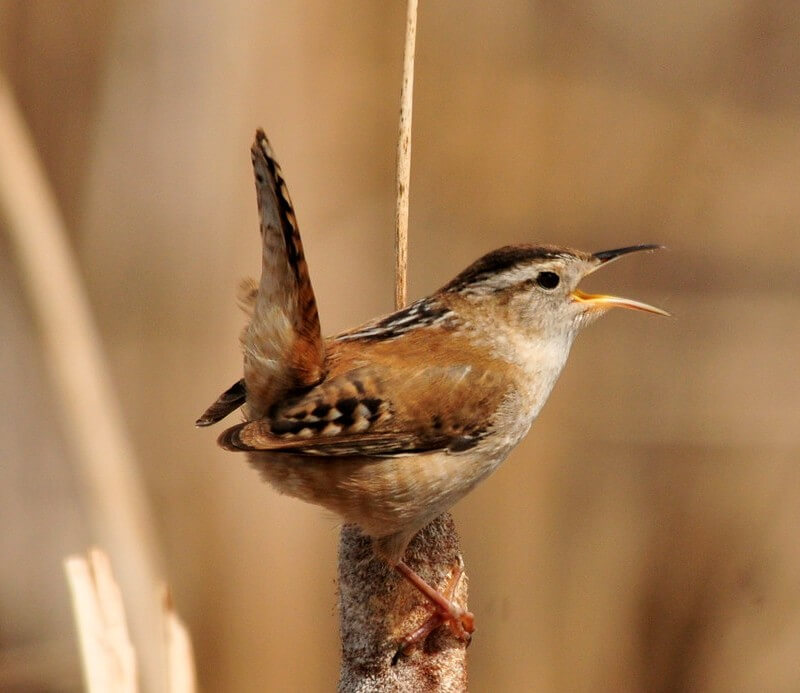
The Marsh Wren can be seen year-round in Nevada.
- Cistothorus palustris
- Size: 5.5″ (14 cm)
- NV Checklist Frequency High: 17% in March
- NV Checklist Frequency Low: 3% in June
Identification and Color: Marsh Wrens are mostly brown with a pale mark right above the eye. They have pale grey or white on their throat and underparts. Brown and black speckled wings and tail feathers. A small, plump, rounded bird, between 3 and 5 inches in length. They have a thin dark bill.
Habitat and Behavior: Found in many different areas. They will breed and summer in the north, migrate to the south for the winter, and some stay permanent residents on the west coast. Likes to be in marshes with a lot of vegetation. Jumps around the vegetation to forage.
Diet: The Marsh Wren mainly eats insects, and some aquatic insects as well. This includes mosquitos, beetles, and moths.
Mourning Dove
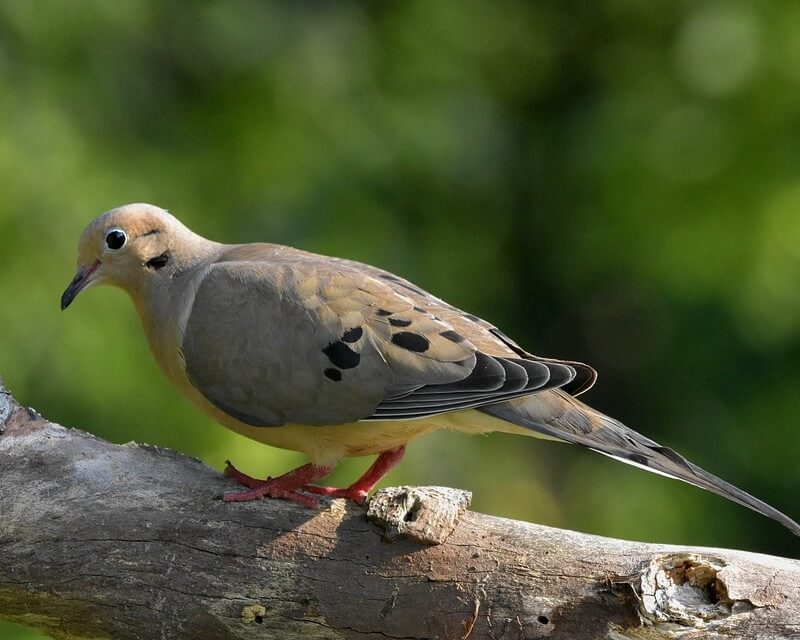
Mourning Doves are one of the most common birds in North America, and they can be found in a variety of habitats throughout Nevada.
- Zenaida macroura
- Size: 12″ (30 cm)
- NV Checklist Frequency High: 49% in May
- NV Checklist Frequency Low: 26% in January
Identification and Color: These slender birds have long, pointed tails and a tiny head. Brown and pale gray plumage with darker streaks on the wings and back.
Habitat and Behavior: Mourning Doves are relatively quiet birds, but they can often be heard cooing softly. Mourning Doves typically nest in trees, but they will also use man-made structures such as window ledges and gutters.
Diet: The Mourning Dove primarily eat seeds, but they will also eat insects and berries
Northern Flicker
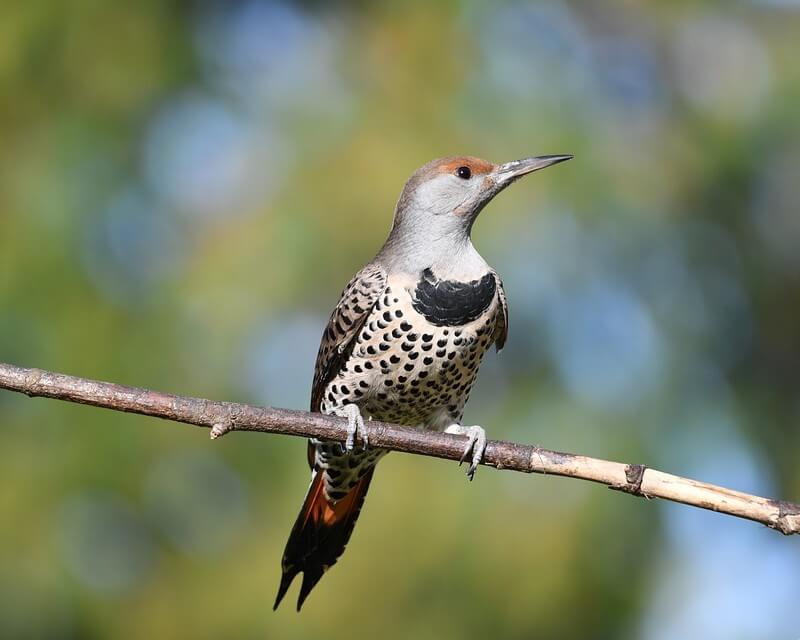
The Northern Flicker is seen year-round in Nevada.
- Colaptes auratus
- Size: 12″ (30 cm)
- NV Checklist Frequency High: 44% in October
- NV Checklist Frequency Low: 10% in May
Identification and Color: A fairly common large woodpecker, but size is where the similarities to other woodpeckers end. The male Northern Flicker is unique with a brown back, black bars and spotted breast. All North American Flickers have white rumps. There are also two different color groups of Northern Flickers – Yellow-shafted and Red-shafted. Yellow-shafted flickers have yellow underwings. Red-shafted flickers have reddish pink underwings.
Habitat and Behavior: Northern Flickers are hole-nesting birds, often making a home in a dead tree. Can be seen hopping around the ground while foraging or latched onto a tree eyeing a spot to search for food.
Diet: Northern Flickers mainly eat insects off the ground, but will also eat berries and nuts.
Northern Mockingbird

The Northern Mockingbird is a common sight in Nevada, known for its distinctive song and plumage.
- Mimus polyglottos
- Size: 10″ (25 cm)
- NV Checklist Frequency High: 22% in May
- NV Checklist Frequency Low: 13% in June
Identification and Color: Northern Mockingbirds are mostly gray in color with white patches on the wings and tail. They have a long black bill and yellow eyes.
Habitat and Behavior: Northern Mockingbirds are found in open habitats such as parks, woods edges, and suburban backyards. They are active throughout the day and are known for their territorial behavior, often chasing away other birds or small animals that come too close to their nest. The Northern Mockingbird is a bit of a joker with its constant imitating of other bird calls.
Diet: Northern Mockingbirds mainly eat insects, but will also eat fruits and berries in the winter.
Red-winged Blackbird

The Red-winged Blackbird is a year-round resident of Nevada, especially near water areas.
- Agelaius phoeniceus
- Size: 8.5″ (22 cm)
- NV Checklist Frequency High: 29% in April
- NV Checklist Frequency Low: 11% in September
Identification and Color: A small black bird with a striking appearance. The male has black feathers and a red patch on each wing, while the female is mostly dark brown with vertical streaks.
Habitat and Behavior: These birds are found in open areas such as marshes, meadows, and fields. Often seen near water, where they build their nests. Red-winged Blackbirds are social birds and often form large flocks.
Diet: The Red-winged Blackbird diet consists of insects, spiders, and other small invertebrates. Will also eat seeds, fruits, and berries.
Say’s Phoebe

The Say’s Phoebe is a year-round resident of Nevada.
- Sayornis saya
- Size: 7″ (18 cm)
- NV Checklist Frequency High: 26% in March
- NV Checklist Frequency Low: 9% in August
Identification and Color: A slender bird with a long tail. They are primarily gray-brown with a reddish underbelly. Males and females are similarly colored, and both have pointed bills. Juveniles are more brown-toned and may have reddish wing bars.
Habitat and Behavior: The Say’s Phoebe is common in the northwest and southwest. Will breed in the northwest and are permanent residents in the southwest. Will perch in a low area waiting for insects.
Diet: Consists almost entirely of insects, including bees, wasps, and winged ants.
Song Sparrow

The Song Sparrow is a small bird commonly found during warmer months in Nevada.
- Melospiza melodia
- Size: 6″ (15 cm)
- NV Checklist Frequency High: 23% in November
- NV Checklist Frequency Low: 8% in August
Identification and Color: The Song Sparrow is brown and gray in color with streaks on its breast and a grayish-brown back. Gets its name from its loud melody.
Habitat and Behavior: Can be found in a variety of habitats including forests, grasslands, and wetlands. The Song Sparrow is a relatively shy bird, but will happily visit bird feeders if food is available.
Diet: Song Sparrows primarily eat insects, but will also eat seeds and berries.
Spotted Towhee

The Spotted Towhee can be seen during the warmer months in Nevada.
- Pipilo maculatus
- Size: 8″ (20 cm)
- NV Checklist Frequency High: 16% in June
- NV Checklist Frequency Low: 6% in August
Identification and Color: Males have black upperparts with spotted white on their backs. Females are gray-brown with the same spot pattern on their backs. Both sexes have a red-brown patch with white bellies. They have long rounded tails with white tips. Thick and pointed bills.
Habitat and Behavior: Found mainly in the Great Plains and the west half of the United States. Birds in the central north often migrate, and many are permanent residents of the south and west. Like to be in open areas that have a lot of shrubs and thick undergrowth. Mainly forages on the ground.
Diet: The Spotted Towhee eats insects, seeds, and berries. Their diet is dependent on the season with insects being eaten in the summer and seeds and berries in the winter.
Western Kingbird

The Western Kingbird can be seen during the warmer months in Nevada.
- Tyrannus verticalis
- Size: 9″ (23 cm)
- NV Checklist Frequency High: 27% in May
- NV Checklist Frequency Low: 0% in Winter
Identification and Color: The Western Kingbird has a grey head with a white throat and chest. They have bright yellow bellies. Their wings are brown and their tails are black with white outlines. Long wings and square-tipped tails. Their bills are straight and heavy.
Habitat and Behavior: They are found in the western half of the United States during the summer. Migrates far south in the winter and some to Florida. They like open areas like grasslands or desert areas. Very territorial and will defend their areas. They forage by watching from their perch which can be either high or low.
Diet: The Western Kingbird mostly eats insects, wasps, bees, and beetles. May eat a small number of berries and fruits.
Western Meadowlark

The Western Meadowlark is commonly seen in Nevada during the warmer months.
- Sturnella neglecta
- Size: 9″ (23 cm)
- NV Checklist Frequency High: 11% in June
- NV Checklist Frequency Low: 3% in February
Identification and Color: A bright yellow underpart that is marked with a black V in the summer and grey in the winter. Heavily streaked with brown, white, and black over their heads, top bodies, wings, and tails. They have short stiff tails and rounded wings. Bills are slender and long. They range about 6 to 9 inches in length.
Habitat and Behavior: The Western Meadowlark is a permanent resident in much of the west and midwest, the north-central states will see the birds migrate. Likes to be in open areas of grasslands and farms. Generally alone or in loose flocks. Will forage on the ground.
Diet: Insects and seeds make up the Western Meadowlarks’ diet.
White-crowned Sparrow

The White-crowned Sparrow is most often seen during the winter months in Nevada.
- Zonotrichia leucophrys
- Size: 6″ (15 cm)
- NV Checklist Frequency High: 60% in October
- NV Checklist Frequency Low: 2% in June
Identification and Color: Most White-crowned Sparrows have black and white stripes around their head. The underpart is gray. They have brown, black, and white coloring on their wings and tail. They have small, pointed bills. Long tails and rounded wings.
Habitat and Behavior: Breeds in the very far north and spends the winter in the very far south. Likes brushy places that are mixed with open and grassy areas. Usually stays low to the ground. Usually forages on the ground or in low shrubs. They usually forage in flocks.
Diet: The White-crowned Sparrow mainly enjoys seeds from weeds or grasses. Will also eat some vegetable matter and insects.
Yellow-rumped Warbler

The Yellow-rumped Warbler is most commonly seen in Nevada during the spring and fall.
- Dendroica coronata
- Size: 6″ (15 cm)
- NV Checklist Frequency High: 50% in October
- NV Checklist Frequency Low: 6% in August
Identification and Color: A small warbler with a soft song, all Yellow-rumped Warblers have a patch of yellow on their sides and rump (hence the name).
Habitat and Behavior: The Yellow-rumped Warbler is typically seen in large flocks during migration in the spring and fall. Enjoys larger open wooded areas as well as brush and thickets. Most often found in trees bearing needles and cones.
Diet: Enjoys insects and berries. Difficult to attract to feeders.
Conclusion
Nevada is home to a variety of backyard birds that can be seen throughout the state. From the colorful Western Tanager to the common Black-capped Chickadee, there is something for everyone to enjoy. With a little patience and a keen eye, you can easily spot these birds in your backyard or neighborhood. With a little bit of knowledge and a little bit of luck, you can make your backyard a haven for these feathered friends. Be sure to check out our other articles about birds in Nevada:
Remember to keep that feeder full and have your checklist ready! Before you go, take a moment to review some of our favorite Nevada birding resources:






